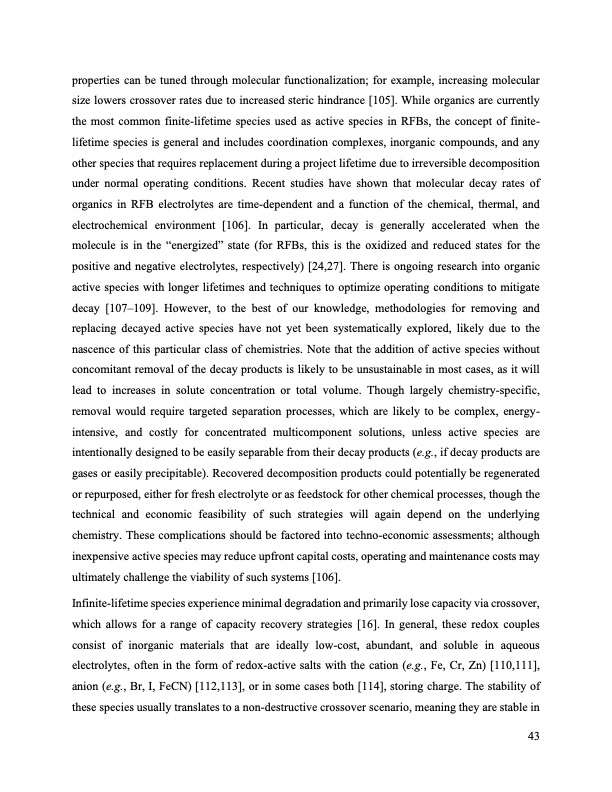
PDF Publication Title:
Text from PDF Page: 043
properties can be tuned through molecular functionalization; for example, increasing molecular size lowers crossover rates due to increased steric hindrance [105]. While organics are currently the most common finite-lifetime species used as active species in RFBs, the concept of finite- lifetime species is general and includes coordination complexes, inorganic compounds, and any other species that requires replacement during a project lifetime due to irreversible decomposition under normal operating conditions. Recent studies have shown that molecular decay rates of organics in RFB electrolytes are time-dependent and a function of the chemical, thermal, and electrochemical environment [106]. In particular, decay is generally accelerated when the molecule is in the “energized” state (for RFBs, this is the oxidized and reduced states for the positive and negative electrolytes, respectively) [24,27]. There is ongoing research into organic active species with longer lifetimes and techniques to optimize operating conditions to mitigate decay [107–109]. However, to the best of our knowledge, methodologies for removing and replacing decayed active species have not yet been systematically explored, likely due to the nascence of this particular class of chemistries. Note that the addition of active species without concomitant removal of the decay products is likely to be unsustainable in most cases, as it will lead to increases in solute concentration or total volume. Though largely chemistry-specific, removal would require targeted separation processes, which are likely to be complex, energy- intensive, and costly for concentrated multicomponent solutions, unless active species are intentionally designed to be easily separable from their decay products (e.g., if decay products are gases or easily precipitable). Recovered decomposition products could potentially be regenerated or repurposed, either for fresh electrolyte or as feedstock for other chemical processes, though the technical and economic feasibility of such strategies will again depend on the underlying chemistry. These complications should be factored into techno-economic assessments; although inexpensive active species may reduce upfront capital costs, operating and maintenance costs may ultimately challenge the viability of such systems [106]. Infinite-lifetime species experience minimal degradation and primarily lose capacity via crossover, which allows for a range of capacity recovery strategies [16]. In general, these redox couples consist of inorganic materials that are ideally low-cost, abundant, and soluble in aqueous electrolytes, often in the form of redox-active salts with the cation (e.g., Fe, Cr, Zn) [110,111], anion (e.g., Br, I, FeCN) [112,113], or in some cases both [114], storing charge. The stability of these species usually translates to a non-destructive crossover scenario, meaning they are stable in 43PDF Image | Bringing Redox Flow Batteries to the Grid

PDF Search Title:
Bringing Redox Flow Batteries to the GridOriginal File Name Searched:
Rodby-krodby-phd-chemE-2022-thesis.pdfDIY PDF Search: Google It | Yahoo | Bing
Salgenx Redox Flow Battery Technology: Salt water flow battery technology with low cost and great energy density that can be used for power storage and thermal storage. Let us de-risk your production using our license. Our aqueous flow battery is less cost than Tesla Megapack and available faster. Redox flow battery. No membrane needed like with Vanadium, or Bromine. Salgenx flow battery
| CONTACT TEL: 608-238-6001 Email: greg@salgenx.com | RSS | AMP |